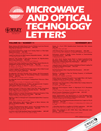Behavioral electromagnetic models of high-speed p-i-n photodiodes
Abstract
This article presents a methodology for developing small-signal behavioral electromagnetic (EM) models of p-i-n photodiodes (PDs) for high-speed applications. The EM model includes RC bandwidth limitation effect and transit-time effect. The model is capable of accurately modeling arbitrary complex parasitics of PD chips. It can be used to predict the optical-to-electrical (O/E) response of PDs with various p-i-n junction structures in the frequency domain at the behavioral level. Compared to equivalent circuit models, EM models avoid developing complicated circuit network to represent complex chip parasitics as well as extracting parasitic values and provide straightforward access to EM characteristics of devices. © 2011 Wiley Periodicals, Inc. Microwave Opt Technol Lett 53:2530–2533, 2011; View this article online at wileyonlinelibrary.com. DOI 10.1002/mop.26327




